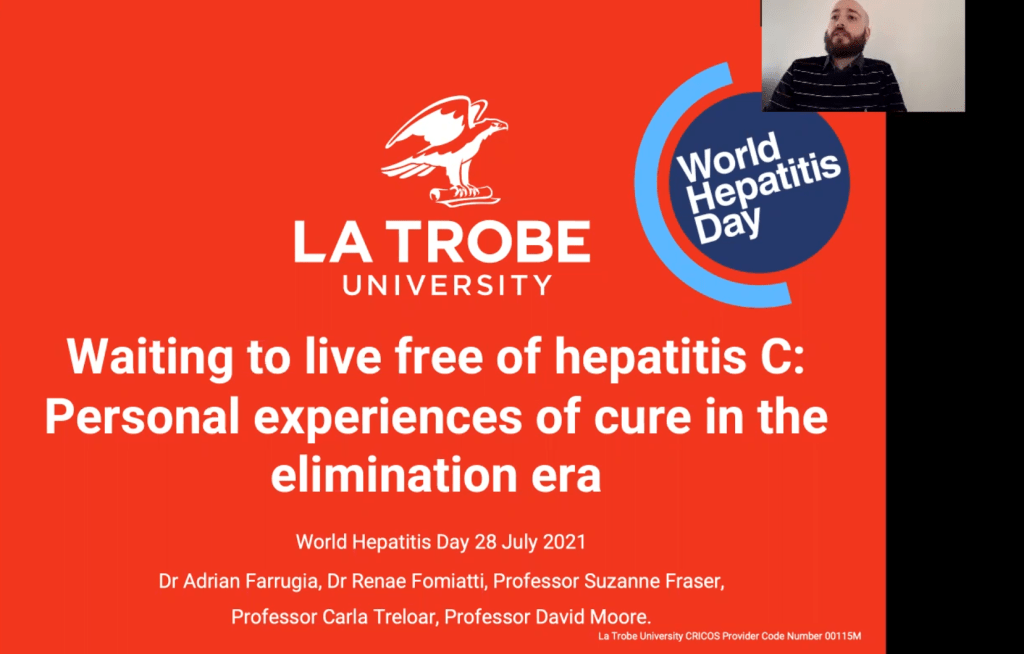Marked annually on July 28, World Hepatitis Day is one of the World Health Organization’s seven global public health days. In an effort to convey the urgency of the current global goal to eliminate hepatitis C by 2030, the theme of this year’s World Hepatitis Day is Hep Can’t Wait. As the event’s website puts it, ‘with a person dying every 30 seconds from a hepatitis related illness – even in the current COVID-19 crisis – we can’t wait to act on viral hepatitis’. One aim, in short, of World Hepatitis Day this year is to build momentum and accelerate progress towards elimination.
The goal of elimination by 2030 is in many ways an important one, yet significant questions remain about how it may be achieved and how it will impact the daily lives of people affected by hepatitis C1. Recent Australian research, for example, indicates that the hopes attached to treatment such as new social connections do not necessarily follow cure2.
Based in the DruGS Program at the Australian Research Centre in Sex, Health and Society (ARCSHS), a major new project began in 2020 to investigate impediments to hepatitis C treatment uptake, including the role of stigma. Entitled ‘Lived experiences of treatment for hepatitis C in Australia: An online resource for people considering treatment, members of the public, healthcare workers and other professionals’, the project was funded by the Australian Research Council to investigate these impediments and produce a public website communicating carefully presented experiences of hepatitis C and treatments. Led by DruGS Program Leader and ARCSHS Director Professor Suzanne Fraser, and building on previous projects producing research-informed websites on health issues, the team collected and analysed interviews with affected individuals to produce urgently needed detailed insights into the experiences of and meanings given to hepatitis C for those affected by it3,4.
Analysing data drawn from this new project, a range of responses to the World Hepatitis Day theme of Hep Can’t Wait can be considered (see findings as a presentation below). While the current generation of hepatitis C treatments are highly tolerable and efficacious, impediments to uptake remain. Access for some is still affected by competing priorities, multiple health conditions, homelessness and stigma.
The researchers also found that cure is not as straightforward as might be expected. Individual experiences of cure can provoke mixed feelings as they are contingent on the same broader social and material forces that shape the emergence of hepatitis C in specific populations, and affect treatment uptake. They are contingent on community understandings of the disease. The research suggests that these broader forces need more attention as they also impact on elimination efforts.
Overall, the research has highlighted that even with new, much easier to manage treatments, people affected by hepatitis C often face difficulties juggling priorities and processes in a context of limited resources and support. As the team found, experiences that might be expected to be straightforward are often complex: intimately shaped by a range of issues beyond those usually considered part of treatment success.
For the team, the Hep Can’t Wait theme prompts thought about broadening the elimination focus beyond treatment uptake alone to the forms of inequality that shape lives and opportunities and priorities in ways that complicate treatment, and that create lingering stigma and discrimination even in the presence of cure1.
As project researcher, Dr Adrian Farrugia explains,
while recent medical developments have placed hepatitis C elimination on the agenda, our research reminds us that meaningful freedom from it – for individuals and the broader community – requires more than treatment alone.
World Hepatitis Day is a reminder of the intimately political nature of hepatitis C and all health issues. In this sense, this year’s message is that people living with the disease should not have to wait for the support and care they need, nor indeed for the equality that may facilitate access and uptake, and that it is necessary to continue to build and deliver hepatitis C elimination efforts fully responsive to and respectful of the fundamental dignity and diversity of those affected5.
See Dr Farrugia’s presentation on these issues, prepared for World Hepatitis Day 2021.

References
- Seear, K., Fraser, S., Farrugia, A. and valentine, k. (2020). Beyond a ‘post-cure’ world: Sketches for a new futurology of hepatitis C. International Journal of Drug Policy. Early online.
- Madden, A., Hopwood, M., Neale, J. and Treloar, C. (2018). Beyond cure: Patient reported outcomes of hepatitis C treatment among people who inject drugs in Australia. Harm Reduction Journal, 15(42), 1-8.
- Treloar, C., Pienaar, K., Dilkes-Frayne, E. and Fraser, S. (2019). Lives of substance: A mixed-method evaluation of a public information website on addiction experiences. Drugs: Education, Prevention and Policy, 26(2), 140-147.
- Farrugia, A., Treloar, C. & Fraser, S. (2021). Overdoselifesavers.org: A mixed-methods evaluation of a public information website on experiences of overdose and using take-home naloxone to save lives. Drugs: Education, Prevention and Policy. Early online.
- Bryant, J., Rance, J., Hull, P., Mao, L. and Treloar, C. (2019). Making sense of ‘side effects’: Counterpublic health in the era of direct-acting antivirals. International Journal of Drug Policy, 72, 77-83.



You must be logged in to post a comment.